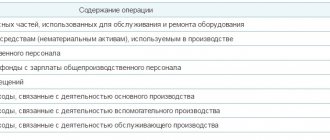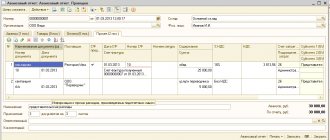Definition
Manufacturing overhead costs are costs directly related to production activities. The main distinguishing feature from direct costs of manufacturing products is that the amounts cannot be attributed to a specific type of product. General production expenses may include costs for:
- depreciation deductions;
- equipment maintenance;
- payment for utility services;
- rent of industrial premises;
- wages for workers involved in the service process;
- other expenses.
Although costs are not directly related to any type of product, they must be taken into account when calculating production costs.
The concept of general expenses
The activities of any enterprise are necessarily connected with the functioning of its various departments. A production workshop cannot operate on its own without management and control employees. The products must then be stored and sold, which requires other personnel and premises. All this leads to the formation of costs that seem to be far from the production process, which are combined into the group of general business expenses.
They may include amounts necessary for:
- covering administrative and management expenses;
- remuneration for employees employed outside production;
- depreciation and repair of general purpose fixed assets;
- payment for rent of non-production premises;
- covering other expenses of a similar nature.
General business expenses are also written off to the cost of manufactured products in accordance with the rules of the enterprise's accounting policy.
Methods for distributing general production and general business expenses
The presence of the specifics of the production process for each individual organization does not imply a universal and strictly fixed division of costs into general economic and general production. Each company independently chooses methods for distributing overhead and general business expenses. The principle of correlating expenses in accounting to one category or another is enshrined in the accounting policy. However, there is a certain general approach that all companies without exception should adhere to. General production expenses include costs for the usual line of business that an enterprise has in connection with the need to maintain its main and auxiliary production facilities. General business expenses include costs associated with managing an organization that are not directly related to the production process. However, they also participate in determining the cost of goods or services produced.
More specifically, general production expenses are the costs of maintaining machinery and equipment, deductions for depreciation and repair costs of fixed assets, costs of various utilities, the purchase of which is necessary as part of the production process, rent of premises, machinery, equipment and others objects used in production, salaries of technical personnel, and so on. In short, these are all those costs that a company can accurately correlate with the production of a specific product.
General business expenses include the costs of maintaining administrative and management personnel not related to the production process, depreciation and other costs of maintaining the operating system and rental and maintenance of premises related specifically to this company structure, costs of paying for information, auditing, consulting services, etc. administrative expenses similar in purpose. Such costs are important for the functioning of the company as a whole, but they cannot be attributed to a specific production process.
How exactly are general production and general business expenses distributed in accounting? Let's try to figure it out.
Characteristics of overhead costs
General production and general business expenses are combined into a group of indirect costs that arise in the course of the enterprise's activities. It is difficult to trace the ratio of their amount to types of products and production time, so they are written off by the method of allocating costs in proportion to a given indicator.
General production and general business expenses are taken into account, highlighting separate cost items and departments (shops). This allows you to control the distribution of funds and identify the most expensive objects to maintain and manufacture.
Overhead costs in accounting data
General and general production expenses in total terms are reflected in synthetic accounts 25 and 26. Both accounts do not have a balance at the end of the month, since they serve to collect and distribute the costs of main production. The amounts are written off to account 20, making entries Dt 20 Kt 25/26. Some enterprises (for example, those providing intermediary services) account for all administrative and general business expenses on account 26, without using account 20.
Analytical accounting is also kept for accounts 25 and 26. Sub-accounts are opened for each workshop, as well as for individual items of general business expenses. When filling out, the accountant is based on data from primary documentation and other forms of accounting registers developed by the enterprise. Additionally, statements No. 12 and 15 are maintained to account for general production and general business expenses.
Account 25: general production expenses. example, wiring
At production cost, when the cost includes: - direct costs (Debit 20 Credit 10, 21, 28, 69, 70); — general production expenses (Debit 25 Credit 02, 10, 23, 69, 70); - general business expenses (Debit 26 Credit 02, 10, 23, 69, 70). The formation of the cost of finished products is reflected by the following entries: Debit 20 Credit 25 – general production (shop) expenses are written off to the main production (the method of distribution by type of product/production is established in the accounting policy); Debit 20 Credit 26 – general business expenses are written off to the main production (the method of distribution by type of product/production is established in the accounting policy); Debit 43 Credit 20 – the cost of finished products has been formed.
There is a production organization where two types of products are assembled, i.e. two “Nomenclature groups”: “Tables” and “Chairs/Armchairs”. Two workers are involved in the production of each type of product.
Attention: Accordingly, we will take into account the costs of paying wages to such employees on account 20.01 “Main production”, according to the corresponding nomenclature group. To implement this in 1C BP 3.0, you must first create two separate methods for accounting for wages (section of the main menu “Salary and Personnel” - “Methods for accounting for wages”). ImportantNow these accounting methods must be assigned to each employee. This could be done in the employee information on the “Payments and Cost Accounting” tab, but for some reason the program does not see this setting. Most likely this is a program error, perhaps it will be fixed soon (the release on the basis of which the article was written: 3.0.37.36).
Typical entries for the debit of accounts 25, 26
Accounting for overhead costs includes collecting information about cost items for maintenance, servicing and fulfilling the needs of main and auxiliary production. Using account 26 pursues the same goals, only the amounts of administrative and management expenses are recorded. Over a certain period, the necessary information is collected in the debit of accounts 25 and 26.
In this case, the following postings Dt 25/26 can be made:
- Kt 02, 05 – depreciation of fixed assets and intangible assets has been accrued;
- Kt 70 – wages accrued to general production (administrative) personnel;
- Kt 69 – social benefits accrued. payments to employees involved in servicing workshops (management employees);
- Kt 76 – general production (general business) expenses include payment of utility bills;
- Kt 10 – materials were sent for the maintenance of production (administrative) facilities.
In addition to the account assignments discussed, others can be used. The main thing is not to violate the principle of double entry and follow the rule of an active account: credit in debit, write-off in credit.
Accounting for overhead costs
To reflect costs that are directly related to the production of any product, the Chart of Accounts uses account 25 “General production expenses”. Postings on it are reflected taking into account information about the costs of servicing the main and auxiliary production facilities of the organization. The debit of this account accumulates data on the composition of costs, which are also reflected in the credit of accounts payable to personnel, accounting for inventory, rental deductions, etc. Simply put, analytical accounting for account 25 can be carried out in the context of various expense items. If the company has many divisions, workshops or similar separate structures, then it is also advisable to carry out analytics on account 25 “General production expenses” taking this factor into account, using additional division. General production expenses are written off by posting from the credit of account 25 to the debit of accounts 20 “Main production”, 23 “Auxiliary production”, 29 “Service production and facilities”. This entry is made at the end of the month, thus the accumulated cost data on account 25 is reset to zero.
An example of reflecting general business expenses and postings:
| D25-K10 | Materials written off for general production purposes |
| D25-K02 | Accrued depreciation of general production equipment |
| D25-K70 | Wages paid to employees involved in production |
| D25-K69 | Insurance premiums are calculated on the wages of workers involved in production. |
| D25-K60 | Works/services of third party suppliers purchased for general production purposes are accepted |
| D20-K25 | General production expenses were written off as expenses of the main production |
Loan transactions: write-off of overhead costs
The instructions for using the standard chart of accounts say that collective synthetic accounts 25 and 26 must be closed at the end of the month. This requirement means that all debit amounts are charged to account 20 (or 90 for general expenses). The accountant will record entries like:
- DT “Main production” CT “Overhead production expenses” – the amounts of general production expenses incurred for the needs of the main production shops are written off;
- Dt “Service production” Kt “Overhead production costs” – the amounts of overhead costs for remuneration of personnel of service production are attributed;
- DT “Auxiliary production” CT “General production expenses” – expenses for utility bills for auxiliary production facilities are written off;
- DT “Main production” CT “General business expenses” – general business expenses were included in the actual production cost;
- Dt “Cost of production” Ct “General expenses” – the amounts of administrative and managerial costs are written off to the cost of production.
Depending on which account the data from the debit turnover of general business expenses is credited to, the full or production cost of the products is formed.
Accounting for direct and indirect costs
To form the cost of products, works, services, as well as to make optimal management decisions, it is extremely important to correctly distribute costs into direct and indirect. With the entry into force of Federal Law No. 58-FZ of June 6, 2005, life has become much easier for accountants. Indeed, from January 1, 2005, the procedure for allocating expenses into direct and indirect, applied in an organization for accounting purposes, can also be used for the purposes of calculating income tax.
In 2005, the organization has the right to establish a uniform composition of direct expenses in both accounting and tax accounting <1>. In this regard, let us recall the basic rules for accounting for costs and their distribution into direct and indirect in accounting.
<1> Read about the new rules for accounting for direct and indirect expenses for profit tax purposes on p. 15. - Approx. ed.
The current accounting legislation does not establish an exact list of expenses related to direct expenses. According to the Instructions for the application of the Chart of Accounts for accounting financial and economic activities of organizations (Order of the Ministry of Finance of Russia dated October 31, 2000 N 94n), the cost of inventories, labor costs, as well as all other expenses “related to directly with the release of products."
Thus, the organization, in its accounting policies for accounting purposes, independently determines which expenses are considered direct.
>Direct and indirect costs for a trading organization
In trade organizations, accounting for direct and indirect costs has its own characteristics.
Production cost
Costs arising in connection with the maintenance or maintenance of production facilities can be attributed to the final result in proportion to the amount specified by the accounting policy. The distribution of overhead costs aims to calculate the cost per unit of production at the exit from the workshop, taking into account all the costs of the industrial cycle.
The distribution of general production and general business expenses when using this method occurs in different ways: from account 25 the amounts are written off to the 20th account, and from 26 to 90. Thus, administrative, managerial and other overhead expenses in terms of general business expenses are not included in the production cost, but relate directly to the financial result.
This is one of the methods that can be applied in an enterprise. Production cost indicators allow you to analyze the profitability of a particular workshop and regulate the amount of costs for the production of certain types of products.
Costs, expenses, cost
11.2):
At the end of the month, the amount of general production expenses recorded in the debit of account 25 “General production expenses” is written off by distributing it to the cost of individual types of products in proportion to the amount of the basic wages of production workers (direct costs of materials, etc.).
General expenses are also classified as overhead expenses. They are related to the management and maintenance of the organization as a whole. The composition and size of these expenses are determined by the estimate.
At the end of the month, the amount of general production expenses recorded in the debit of account 25 “General production expenses” is written off by distributing it to the cost of individual types of products in proportion to the amount of the basic wages of production workers (direct costs of materials, etc.).
Table 11.2 Typical correspondence of accounts for accounting for overhead costs
At the end of the month, the amount of general production expenses recorded in the debit of account 25 “General production expenses” is written off by distributing it to the cost of individual types of products in proportion to the amount of the basic wages of production workers (direct costs of materials, etc.).
General expenses are also classified as overhead expenses. They are related to the management and maintenance of the organization as a whole. The composition and size of these expenses are determined by the estimate.
Synthetic accounting of general business expenses is carried out on the active collection and distribution account 26 “General business expenses”, and analytical accounting - on account 26 “General business expenses” according to budget items in a separate statement.
Planning and accounting of general business expenses is carried out according to the following nomenclature of items:
content of the management apparatus;
expenses for business trips of the management staff;
maintenance of fire, paramilitary and security guards;
entertainment expenses related to the activities of the organization;
maintenance of other business personnel;
office and postal expenses;
depreciation of fixed assets for general purposes;
deductions to the repair fund or costs for routine repairs of buildings, structures and equipment for general purposes;
expenses for the maintenance of buildings, structures and equipment for general purposes;
costs of testing, experiments, research, maintenance of general economic laboratories;
expenses for labor protection of the organization’s employees;
training and retraining of personnel;
mandatory deductions, taxes and fees;
unproductive general business expenses, etc.
All actual costs are collected and reflected in accounting records (Table 11.3):
Table 11.3 Typical correspondence of accounts for accounting for general business expenses
Continuation of the table. 11.3
At the end of each month, general business expenses are written off to the credit of account 26. General business expenses are distributed between finished products and work in progress remaining at the end of the reporting month. Then the costs attributable to finished products are distributed among their individual types in proportion to the selected base or write-off method. These expenses can be written off in two ways:
1) inclusion in the production costs of specific types of products through distribution similar to the distribution of overhead costs;
2) writing off general business expenses as semi-fixed ones to the “Sales” account by distributing them between types of products sold.
When writing off general business expenses to account 90 “Sales”, they are distributed by type of products, works or services sold in proportion to sales revenue, production cost of products or other indicator.
The choice of one or another method of writing off general business expenses should be reflected in the accounting policy of the organization. Of course, the second method greatly simplifies the write-off of general business expenses. However, it is applicable provided that all products to which general business expenses relate are sold or the share of these expenses in the cost of production is insignificant.
The actual data, after accounting and distribution of overhead costs, are entered into the summary accounting sheet for the costs of production of products (works, services).
Pages: …7071727374…| Table of contents
Ask a free question to a lawyer!
Cost and taxation
In order not to create additional registers for tax accounting purposes, it is better to account for overhead costs at the full production cost. The method involves writing off to the debit of account 20 both general production and general business expenses. The accountant’s choice of a method for attributing indirect costs to the cost of products should be based primarily on the provisions of the enterprise’s accounting policy.
General production expenses (account 25) and expenses for general business needs, together with data from account 20, make up the bulk of the cost of manufactured products. The data is used both for the purposes of accounting and analysis of the financial activities of the enterprise, and for tax service data.





